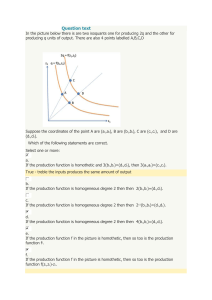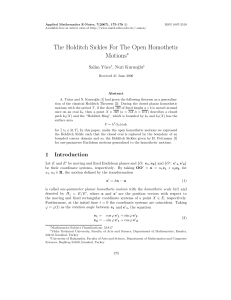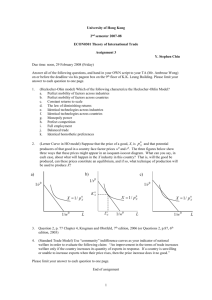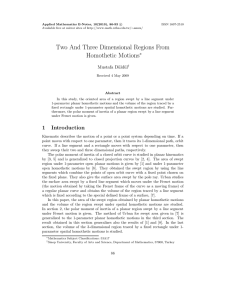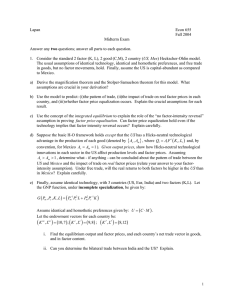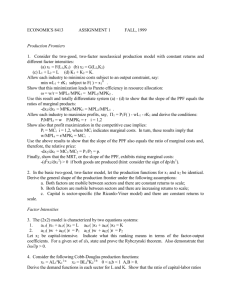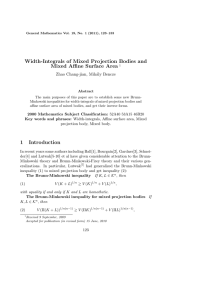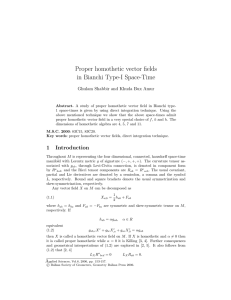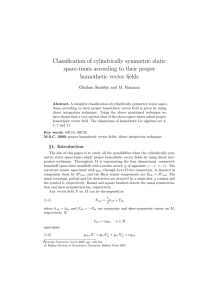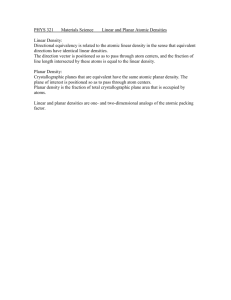Document 10677266
advertisement
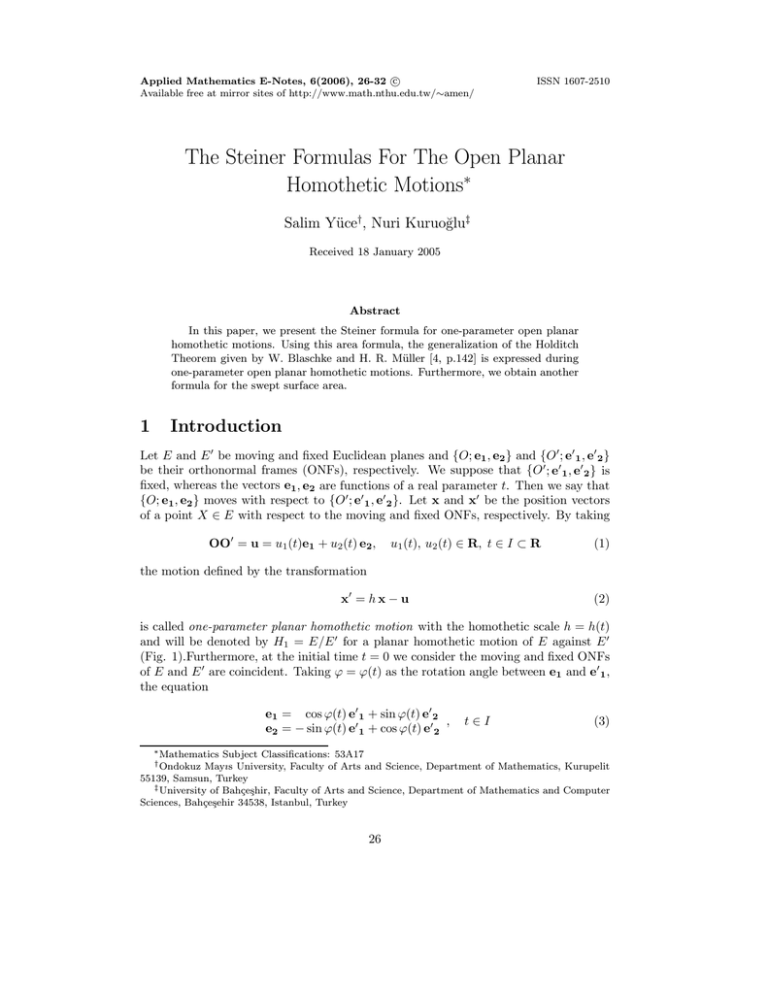
Applied Mathematics E-Notes, 6(2006), 26-32 c
Available free at mirror sites of http://www.math.nthu.edu.tw/∼amen/
ISSN 1607-2510
The Steiner Formulas For The Open Planar
Homothetic Motions∗
Salim Yüce†, Nuri Kuruoğlu‡
Received 18 January 2005
Abstract
In this paper, we present the Steiner formula for one-parameter open planar
homothetic motions. Using this area formula, the generalization of the Holditch
Theorem given by W. Blaschke and H. R. Müller [4, p.142] is expressed during
one-parameter open planar homothetic motions. Furthermore, we obtain another
formula for the swept surface area.
1
Introduction
Let E and E 3 be moving and fixed Euclidean planes and {O; e1 , e2 } and {O3 ; e3 1 , e3 2 }
be their orthonormal frames (ONFs), respectively. We suppose that {O3 ; e3 1 , e3 2 } is
fixed, whereas the vectors e1 , e2 are functions of a real parameter t. Then we say that
{O; e1 , e2 } moves with respect to {O3 ; e3 1 , e3 2 }. Let x and x3 be the position vectors
of a point X ∈ E with respect to the moving and fixed ONFs, respectively. By taking
OO3 = u = u1 (t)e1 + u2 (t) e2 ,
u1 (t), u2 (t) ∈ R, t ∈ I ⊂ R
(1)
the motion defined by the transformation
x3 = h x − u
(2)
is called one-parameter planar homothetic motion with the homothetic scale h = h(t)
and will be denoted by H1 = E/E 3 for a planar homothetic motion of E against E 3
(Fig. 1).Furthermore, at the initial time t = 0 we consider the moving and fixed ONFs
of E and E 3 are coincident. Taking ϕ = ϕ(t) as the rotation angle between e1 and e3 1 ,
the equation
e1 = cos ϕ(t) e3 1 + sin ϕ(t) e3 2
,
e2 = − sin ϕ(t) e3 1 + cos ϕ(t) e3 2
∗ Mathematics
t∈I
(3)
Subject Classifications: 53A17
Mayıs University, Faculty of Arts and Science, Department of Mathematics, Kurupelit
55139, Samsun, Turkey
‡ University of Bahçeşhir, Faculty of Arts and Science, Department of Mathematics and Computer
Sciences, Bahçeşehir 34538, Istanbul, Turkey
† Ondokuz
26
S. Yüce and N. Kuruoğlu
27
can be written.
a%
a %
%
a
%
a
%
a
%
a
3
%
X
a
]
%
a
Ea
a
a
#
a
&
%
%
a
%
%
hx a
% e%
ae1 a
a
&
%
#
x3
a
% 2 % a
e32 a
%
%
a
`
`
aO a
%` a
``
8
``` u % 8
`
`
a ϕ a !
`` !
a
%a
e31
O3
E3
Fig. 1
During the homothetic motion H1 , the homothetic scale h, the rotation angle ϕ
and the vectors x, x3 and u are continuously differentiable functions of a real time
parameter t.
If there exists a smallest real number T > 0 such that
uj (t + T ) = uj (t), j = 1, 2,
h(t + T ) = h(t),
ϕ(t + T ) = ϕ(t) + 2πν,
h(0) = h(T ) = 1,
ν∈Z
∀t ∈ R,
then H1 is called one-parameter closed planar homothetic motion with the period T
and the number of rotations ν. Otherwise, H1 is called one-parameter open planar
homothetic motion. During the homothetic motion H1 , to avoid the case of pure
translation we assume that
ϕ̇(t) = dϕ/dt = 0.
If we differentiate eqs.(2) and (3) with respect to t, we get the sliding velocity of moving
point X = (x1 , x2 ) ∈ E as
Vf = {−u̇1 + (u2 − hx2 )ϕ̇ + ḣx1 }e1 + {−u̇2 + (−u1 + hx1 )ϕ̇ + ḣx2 }e2 .
(4)
If Vf = 0 (i.e. for the points that are fixed in both E and E 3 ), then we obtain
p1 =
ḣ(u̇1 − u2 ϕ̇) + hϕ̇ (u̇2 + u1 ϕ̇)
ḣ(u̇2 + u1 ϕ̇) − hϕ̇ (u̇1 − u2 ϕ̇)
, p2 =
ḣ2 + (hϕ̇)2
ḣ2 + (hϕ̇)2
(5)
28
Steiner Formulas For Homothetic Motions
where the point P = (p1 , p2 ) is called the rotation pole or center of the instantaneous
rotation of the homothetic motion H1 . Also the set of the pole points on E and E 3
are called the moving and fixed pole curves and denoted by (P ) and (P 3 ), respectively.
Using the pole point we can rewrite eq.(4) as
Vf = {(x1 − p1 )ḣ − (x2 − p2 )hϕ̇}e1 + {(x1 − p1 )hϕ̇ + (x2 − p2 )ḣ}e2 .
2
The Steiner Formulas For The Open Planar Homothetic Motion
2.1
I.
We will study surface area swept out by the segment Q3 X, which is occurred by a fixed
point X = (x1 , x2 ) ∈ E and the fixed point Q3 ∈ E 3 , under the open homothetic motion
t
H1 : If H1 is restricted to time interval [t1 , t2 ], then, the segment Q3 X (t ∈ I = [t1 , t2 ])
sweeps a surface with the orientated area
3
Q
FX
=
1
2
]
t2
t1
[x3 − q3 , dx3 ],
(6)
where the symbol [α, β] is used instead of the area of parallelogram constituted by
the vectors α and β.From the sliding velocity of a fixed point X = (x1 , x2 ) ∈ E with
respect to E 3 , we have
dx3 = {(x1 − p1 )dh − (x2 − p2 )hdϕ}e1 + {(x1 − p1 )hdϕ + (x2 − p2 )dh}e2 .
(7)
If we substitute eqs.(2), (5) and (7) into eq. (6), then we find
Q3
2FX
=
(x21
+
x22 )
]
t2
t1
+
]t2
t1
+x1
2
h dϕ − x1
]
t2
t1
2
(q1 + p1 ) h dϕ − x2
]t2
(q2 + p2 )h2 dϕ
t1
[(q1 p1 + q2 p2 )h2 dϕ + (q1 p2 − q2 p1 )hdh]
]t2
t1
(q2 − p2 )h dh + x2
]t2
(−q1 + p1 )h dh
(8)
t1
If X = O (x1 = x2 = 0) is taken, then for the swept surface area of the segment
Q3 O, we get
] t2
Q3
2FO =
[(q1 p1 + q2 p2 )h2 dϕ + (q1 p2 − q2 p1 )hdh].
(9)
t1
S. Yüce and N. Kuruoğlu
29
Moreover, since ϕ̇(t) = 0 and ϕ̇(t) is a continuous function, we can say that ϕ̇(t) < 0
or ϕ̇(t) > 0, that is, ϕ̇(t) has the same sign in everywhere in the closed interval [t1 , t2 ].
Hence using the mean value theorem of integral-calculus for time interval [t1 , t2 ], there
exists at least one point t0 ∈ [t1 , t2 ] such that
]t2
2
h dϕ =
t1
where δ =
Ut2
]t2
h2 ϕ̇ dt = h2 (t0 )δ,
(10)
t1
dϕ is total rotation angle (Gesamtdrehwinkel) of the motion. The Steiner
t1
point S = (s1 , s2 ),which is the center of gravity of the moving pole curve, is given by
sj =
Ut2
h2 pj dϕ
t1
Ut2
, j = 1, 2.
(11)
h2 dϕ
t1
Then from eqs.(8), (9) and (10), we get
3
δ
Q3
FX
= FOQ + h2 (t0 ) (x21 + x22 − 2 a1 x1 − 2 a2 x2 ) + µ1 x1 + µ2 x2 ,
2
(12)
such that
2
2h (t0 )aj δ =
]t2
1
(qj + pj )h dϕ, µ1 =
2
2
t1
]t2
t1
1
(q2 − p2 )h dh, µ2 =
2
]t2
(−q1 + p1 )h dh.
t1
Eq.(12) is called the Steiner formula for the open planar homothetic motion H1 .
So, using eq. (12), we can give the following theorems without proof.
THEOREM 1. During the open homothetic motion H1 , all the fixed points X =
Q3
(x1 , x2 ) ∈ E which have equal surface area FX
lie on the same circle with the center
C = (s1 −
µ1
,
2
h (t0 )δ
s2 −
µ2
)
2
h (t0 )δ
in the moving plane E.
Special case 1. In the case of homothetic scale h ≡ 1, from eq. (12), we get
3
Q
= FO +
FX
δ 2
(x + x22 − 2s1 x1 − 2s2 x2 )
2 1
which was given by Blaschke and Müller [4, p. 117]. If H1 is the closed planar homothetic motion (δ = 2π ν), then from eq. (12), we get
FX = FO + h2 (t0 )πν(x21 + x22 − 2s1 x1 − 2s2 x2 ) + µ1 x1 + µ2 x2 ,
which was given by Tutar and Kuruoğlu [1].
30
Steiner Formulas For Homothetic Motions
THEOREM 2. Let A, B and X be three collinear points in E and Q3 be a fixed
3
3
point in E 3 . During the open homothetic motion H1 , for orientated areas FAQ , FBQ
Q3
and FX
of surfaces swept out by the segments Q3 A, Q3 B and Q3 X, respectively, we
get
3
3
3
Q
FX
= [aFBQ + bFAQ ]/(a + b) − h2 (t0 )abδ/2.
(13)
Special case 2. In the case of homothetic scale h ≡ 1, from eq. (13), we have
3
3
3
Q
= [aFBQ + bFAQ ]/(a + b) − abδ/2,
FX
which was given by Pottmann [2]. If H1 is the closed planar homothetic motion (δ =
2π ν), then we obtain
FX = [aFB + bFA ]/(a + b) − h2 (t0 ) π ν ab,
which was given by Kuruoğlu and Yüce [3].
Moreover, if we choose another point instead of the fixed point Q3 ∈ E 3 on the fixed
plane E 3 , then eq. (13) is also valid.
2.2
II.
P
Under the open homothetic motion H1 , we now calculate the area FX
of surface swept
by the pole ray PX. If we divide the area element df of the swept surface into “partial
triangle” as shown in Fig. 2, then from Fig. 3,
Fig. 2 and Fig. 3
we can write
df =
1
1 3
[x − p3 , dx3 ] + [P3 1 X3 1 , dp3 ]
2
2
or
df =
1
1 3
[x − p3 , dx3 ] + [x3 + dx3 − p3 − dp3 , dp3 ].
2
2
S. Yüce and N. Kuruoğlu
31
Since [dx3 , dp3 ] = 0 and [dp3 , dp3 ] = 0, we have
1 3
1
[x − p3 , dx3 ] + [x3 − p3 , dp3 ].
2
2
If we denote |x − p| = a, then we get
df =
[x3 − p3 , dx3 ] = h2 a2 dϕ.
(14)
(15)
Also, since x3 − p3 = h(x − p) and dp3 = hdp, we get
1 3
1
(16)
[x − p3 , dp3 ] = h2 [p − x, dp] = h2 (−d∆P ),
2
2
where d∆p is the area of “infinitesimal triangle” swept out by the pole ray PX on the
moving plane E.
If we substitute eqs.(15) and (16) into eq. (14), we get
1 2 2
h a dϕ − h2 d∆P .
2
If we integrate the eq.(17) for t ∈ [t1 , t2 ], then we obtain
df =
P
FX
1
=
2
]t2
t1
2
2
h (t)a (t)dϕ(t) −
]t2
h2 (t) d∆p (t).
(17)
(18)
t1
Using the mean value theorem of integral-calculus for the interval [t1 , t2 ], there exists
at least one point t0 ∈ [t1 , t2 ] such that
]t2
h2 (t)a2 (t)dϕ(t) = h2 (t0 )
t1
]t2
a2 (t)dϕ(t)
(19)
t1
and
]t2
h2 (t) d∆p (t) = h2 (t0 )∆P .
(20)
t1
If we substitute eqs. (19) and (20) into eq (18), we get
P
FX
1
= h (t0 ){
2
2
]t2
t1
a2 (t)dϕ(t) − ∆P },
(21)
where ∆P is the area of triangle bounded by the pole rays Pt1 X,Pt2 X of the moving
plane E and the arc segment between the points Pt1 ,Pt2 of the moving pole curve (P ).
Special case 3. In the case of the homothetic scale h ≡ 1, we get
P
FX
1
=
2
]t2
t1
a2 (t)dϕ(t) − ∆P
which was given by Blaschke and Müller [4,p. 118].
32
Steiner Formulas For Homothetic Motions
References
[1] A. Tutar and N. Kuruoğlu, The Steiner formula and the Holditch theorem for the
homothetic motions on the planar kinematics, Mech. Mach. Theory, 34 (1999),1-6.
[2] H. Pottmann, Zum Satz von Holditch in der euklidischen Ebene, El. Math., 41
(1986), 1-6.
[3] N. Kuruoğlu and S. Yüce, The generalized Holditch theorem for the homothetic
motions on the planar kinematics, Czech Math. J., 54(2) (2004), 337-340.
[4] W. Blaschke and H. R. Müller, Ebene Kinematik, Oldenbourg, München, 1956.
